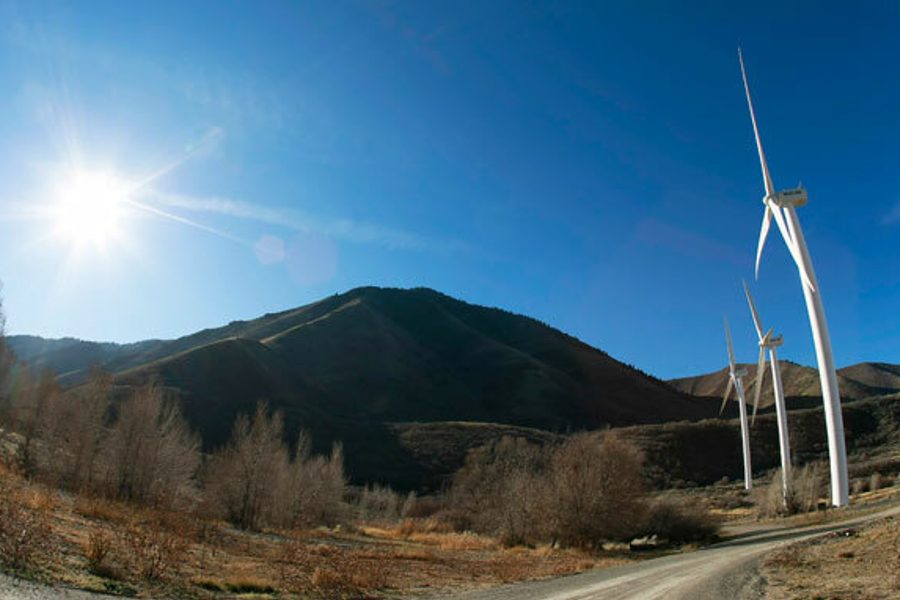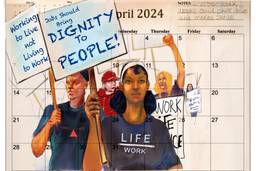Green Jobs for Whom?
Obama must ensure that the green economy provides a living wage and opportunity for all.
Christopher Weber

Until recently, most people had never heard of “green-collar jobs.” Yet the phrase is suddenly on policymakers’ tongues.
House Speaker Nancy Pelosi (D-Calif.) has spoken out for such jobs. So has Sen. Edward Kennedy (D-Mass.). Last year, incoming Secretary of Labor Hilda Solis introduced a green-collar bill in the House. Even Republican Minnesota Gov. Tim Pawlenty has noted, “the development of green jobs will be one of the biggest changes in our economy since the industrial revolution.”
For his part, President Obama has made green-collar jobs a major part of his approach to the economic crisis. On Dec. 6, he said, “We will create millions of jobs by making the single-largest new investment in our national infrastructure since the creation of the federal highway system in the 1950s.”
But will these jobs be as plentiful – and as worker-friendly – as the new administration and environmentalists would have us believe? And can green businesses really create opportunities for workers given the current economic crisis?
An economic shift
Green-collar jobs are already a growing part of the U.S. economy. As demand has risen for clean energy and environmentally responsible manufacturing, workers are turning out everything from hybrid cars to organic cotton underwear.
In most scenarios, a green-collar worker is one who translates new environmental technologies for consumers, designing and manufacturing goods that use fewer materials and less energy than those of just a few years ago. Environmental groups from the Sierra Club to the League of Conservation Voters say these jobs are a victory for the environment and for workers.
“This is a great time for us to ramp up the level of investment in clean energy,” says Pete Altman, climate campaign director for the Natural Resources Defense Council (NRDC). “Significantly more people can be employed in energy-efficiency retrofits and building wind and solar plants per dollar invested than just buying natural gas or oil or coal.”
One of the grandest election promises – aside from liberating the nation from foreign oil – was to create a sizeable pool of new jobs. On the campaign trail, Obama offered a plan to create 5 million green-collar jobs over 10 years. He promised to support this initiative with $150 billion from the federal coffers.
During his Dec. 6 address, Obama condensed the proposed timeframe for this green investment to two years. He outlined green jobs and infrastructure improvements as part of his much larger economic stimulus plan intended to jolt the anemic U.S. economy. Up to $100 billion would go to upgrading the nation’s infrastructure, with schools, hospitals and communication systems targeted for “green” improvements.
At the same time, more radical visions for the green economy are gaining support. Two progressive think tanks, the Center for American Progress (CAP) and the Apollo Alliance, have argued for “green recovery” plans – economic roadmaps that emphasize the key role of green jobs.
CAP commissioned a study by the Political Economy Research Institute at the University of Massachusetts-Amherst. Unveiled in September, “Green Recovery: A Plan to Create Good Jobs and Start Building a Low-Carbon Economy” urges investment in retrofitting buildings for energy efficiency; expanding public transit and freight rail; building a cutting-edge electrical grid; and developing wind, solar and biofuel energy. It also notes:
Public and private investment in energy efficiency reduces energy demand and lowers energy costs. … Lowering energy costs for educational buildings eventually means more funds for teachers, books and scholarships. Retrofitting hospitals over time releases money for better patient care.
These improvements will lead to the creation of 2 million jobs in two years, according to the study’s authors, Robert Pollin, Heidi Garrett-Peltier, James Heintz and Helen Scharber. About half of the jobs would be in construction and manufacturing. The rest would come as suppliers, retail and other industries ramp up behind this growth. All told, the authors estimate that their approach would cost taxpayers about $100 billon over two years.
Several unions, including the AFL-CIO, support an aggressive stimulus like the one proposed by the study.
“I think everybody in the labor movement recognizes that we have to make this economy more sustainable as well as more just,” says Ron Blackwell, AFL-CIO chief economist. “The particular challenge is to make the transition to a greener economy in a way that does not impose disproportionate costs on working families.”
Blackwell points out that the $150 billion Obama has committed to a green economy is only a first step. Still, he says the precedent is encouraging him: “We need to shift from an economy driven by asset inflation – equities in the 1990s and housing since 2000 – to more sustainable, public-led growth to restore the competitiveness of our national economy.”
Cleaner, greener labor
Labor unions and their workers could benefit by organizing this emerging green workforce.
“A lot of industries that stand to grow and prosper in a green economy are ones that you might not expect,” says David Foster, longtime regional director for the United Steelworkers. “A lot of people think of steel as a dirty, un-environmentally friendly industry, but the average wind turbine shaft contains 300 cubic tons of steel.”
Foster currently serves as the executive director for the Blue-Green Alliance, a labor-environmental partnership that wants to see quality jobs emerge from green investment. The alliance began with a 2006 pact between the United Steelworkers and the Sierra Club. In October, the Communications Workers of America joined the alliance, as did the NRDC.
“We’ve been building partnerships between environmental groups and organizations, especially labor, because we have a lot in common,” explains the NRDC’s Altman. “Some of the toughest problems that we face in the United States can be answered by investing in and building our economy around clean energy sources. That creates the environmental benefits we need to keep our world healthy and clean. These are also energy sources that put more people to work by creating more good-paying jobs than traditional energy sources.”
The emphasis on emerging technologies might make it seem that workers trained in the old “brown” economy are in trouble. But that’s far from true.
“Virtually all the jobs that will be generated by green investments will be for people doing the kind of work they are already doing,” says Robert Pollin, a University of Massachusetts-Amherst professor of economics and lead author of “Green Recovery.” “In my view, there is no such thing as ‘green skills’ as distinct from the skills most workers already have.”
Unions aren’t championing green-collar jobs solely out of labor concerns. Foster says they’re also moved by environmental values.
Six years after the Steelworkers was founded, it helped launch investigations into the 1948 “Killer Fog” disaster in Donora, Pa., in which toxic fumes from several steel mills became trapped over the town, killing 20 people. By 1955, these investigations led to the passage of the state’s Clean Air Act, the first of its kind in the nation.
“Steelworkers have drawn close connections between pollution in the workplace and pollution generally,” says Foster.
Where are the jobs for women?
A growing chorus of feminist writers and economists are asking about women’s place – or lack of one – in the green economy. In a Dec. 9 New York Times op-ed, Linda Hirshman, author of Get to Work: A Call to Arms for Women of the World, wrote that most green-collar job proposals, including Obama’s, focus too heavily on construction and engineering trades dominated by men.
“It is possible that you could, without employing a single female, build your way out of this economic crisis if you spent a humongous amount of money on really energy-efficient things like railroads,” Hirshman says. “But by concentrating so hard on this macho attitude toward environmental pollution, you would miss an opportunity to solve two problems at once” – that is, global warming and gender inequality.
Hirshman points out that Obama, in his December address, compared his building program to President Eisenhower’s 1956 Federal Aid Highway Act, a parallel that she says dismays her. “I think Barack Obama and his staff have been watching too many episodes of ‘Bob the Builder,’ with their determination to build roads and bridges,” she says. “Roads and bridges are what got us into this climate pickle in the first place.”
Hirshman says innovative ways exist for women to enter the green-collar workforce in large numbers. “Nine percent of the construction workers in the United States are female, a very tiny number. If you exclude the secretaries, it’s 3 percent.” An affirmative action program for all federally funded construction projects could dramatically boost this number, she says.
Women workers could also spearhead efforts to retrofit the nation’s buildings, Hirshman argues. Given the experience of many women as teachers and communicators, they are ideally suited, she says, to serve as “green counselors,” working with homeowners and landlords to weatherize homes for greater energy efficiency. “You wouldn’t have to have apprenticeship in the construction trades or a degree in engineering or any of the things that are current barriers to women.”
Ensuring ‘green-collar’ jobs are good jobs
Greg Norton, a retired union steelworker in Dundee, Ill., says he worries about “the long-term prospect of keeping [green] jobs in the United States. The same forces in the marketplace that have managed to destabilize the housing industry can just as easily export any new ‘green’ manufacturing jobs to wherever they find most profitable for themselves.”
Others like Laura Owen, a labor economist at DePaul University, find hope in the promised federal investment. “The question I would ask is whether the technological knowledge for outsourcing green technology exists in all other countries,” she says. “Encouraging production on a larger scale through government assistance can help reduce costs and give the new firms advantages over future competitors.”
However, current trade agreements pose a significant barrier to any federal invesment in green jobs. According to consumer watchdog group Public Citizen, a stimulus package that provides funds, tax breaks or loan guarantees to green businesses could run askew of World Trade Organization (WTO) rules banning such subsidies.
Thus, trade reform is critical to building the green economy. Obama has indicated he wants trade rules renegotiated in favor of green businesses. He wrote to the Oregon Fair Trade Coalition last May, “I will take all the necessary and appropriate steps to ensure that policies designed to reduce global warming pollution are not constrained by trade agreements.”
What those “appropriate steps” entail remains to be seen, but the United States will have to incorporate environmental standards to a much greater degree than the WTO does. Under current law, corporations can elude emission standards by setting up their dirtier operations overseas – nullifying green jobs in the process. To address this problem, in December 2007, Obama pledged to the Iowa Fair Trade Campaign to have “binding environmental standards” added to trade agreements, “so that companies from one country cannot gain an economic advantage by destroying the environment.”
As for wages, the best way to ensure that all green-collar positions pay a living wage, according to Pollin, is to push for a low unemployment rate of 4 percent or less. “Historically, those circumstances have forced wage increases and better conditions for low-wage workers,” he says. “Beyond that, we need the traditional institutions – decent minimum wages and union bargaining power – to make sure the employment expansion generates decent jobs, not poverty-level jobs.”
Van Jones, founder and president of the advocacy group Green for All, argues that the new economy must address social and economic injustices. In his book, The Green-Collar Economy, Jones writes that green jobs can uplift marginalized workers:
The green economy should not just be about reclaiming thrown-away stuff. It should be about reclaiming thrown-away communities. … Formerly incarcerated people deserve a second shot at life – and all obstacles to their being able to find that second chance in the green sector should be removed. Also, our urban youth deserve the opportunity to be part of something promising. Across this nation, let’s honor the cry of youth in Oakland, Calif., for “green jobs, not jails.”
Activists and local politicians are now building training programs so that low-income workers, people of color and immigrants can access green-collar jobs.
In New York, Sustainable South Bronx runs a program that teaches participants how to install green roofs, clean toxic spills and restore rivers. Of the 128 low-income workers who have completed the program, 85 percent currently have jobs. In California, Women’s Action to Gain Economic Security has helped low-income immigrant women build four successful green housecleaning cooperatives that employ hundreds. And in Chicago, Growing Home has trained 100 formerly incarcerated, homeless or addicted individuals in organic farming. Sixty-five program graduates are now employed, and 90 have found permanent housing.
In 2008, similar training programs opened in Los Angeles, Newark and Oakland. Obama has also pledged to expand federal job-training programs to include green skills.
But for all its promise, the green economy offers no guarantees of justice for workers. Campaigns to raise wages, to improve benefits and to unify labor will remain as important in the green future as they are in the present.






